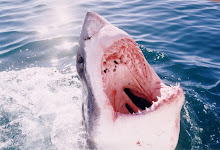
The In-House Marine Biologist of WHITE SHARK PROJECTS, Adrian Hewitt, share some of his interesting observations on the behaviour of summer sharks versus winter sharks. White Shark Projects is located within the small village of Kleinbaai, Gansbaai, South Africa, home to the Great White Shark.
Great white sharks in South Africa have distinct localised seasonal migration patterns. Typically in the summer months running from August through February, large (4.0 metre) females and small (<>
During winter months spanning March through August white sharks frequent off shore islands such as Dyer Island and Geyser Rock. Other islands along the South African coastline include Seal Islands in False Bay, Mossel Bay and Bird Island in Algoa Bay. Winter months are the peak time for white shark abundance and sightings at all of these locations. Sharks around Dyer Island are typically of intermediate size (3.5 metre).
The reason for inshore/ offshore seasonal migration is unknown to date although various theories have been suggested including a change in prey and even reproduction!
Whist frequenting these offshore islands great whites prey on the Cape fur seal, Arctocephalus pusillus. Cape fur seals are born around November and nourished by the mother’s milk for several months whilst they build up fat reserves. They are not inherently born with the ability to swim which is something that must be learnt by trial and error taking about three to four months of practice. Inexperienced, plump seal pups are exactly what the white shark is looking for in a meal. The blubber layer is very rich in energy and ideal fuel for a white shark! The sharks will prey on these seal pups until the start of the summer season when for some reason they leave the island all together. Historically large shoals of yellowtail and other fish species run through the bays in summer months. It is thought that white sharks may follow these aggregations inshore to feed, leaving the now shark-wise seals alone. Great whites also prey upon other shark, skate and ray species which are found in the bays.
Very little is known about white shark reproduction, what we do know comes from the examination of deceased sexually mature specimens and from inferences drawn from other closely related Lamnoids (mackerel sharks), the great whites cousins! White sharks have never been observed giving birth or mating, this still remains a mystery to date. As very large females and small juveniles are typically observed in shore in the summer, the bays have been theorised to be mating, pupping and nursery grounds.
The white shark must swim throughout its life time in order to pass water over the gills and extract oxygen, if it stops swimming it will suffocate. Some suggestions have been put forward that they breed in shore as males and females, whilst mating, can stop swimming and sink to the soft sea bed in the wave zone. This area is turbulent with a lot of oxygen being available. Once the act of mating has finished they may well be able to revive much quicker due to the elevated oxygen levels.
Both a prey shift and reproduction as reasons of inshore/ offshore seasonal migration are just theory and this still awaits scientific confirmation.





